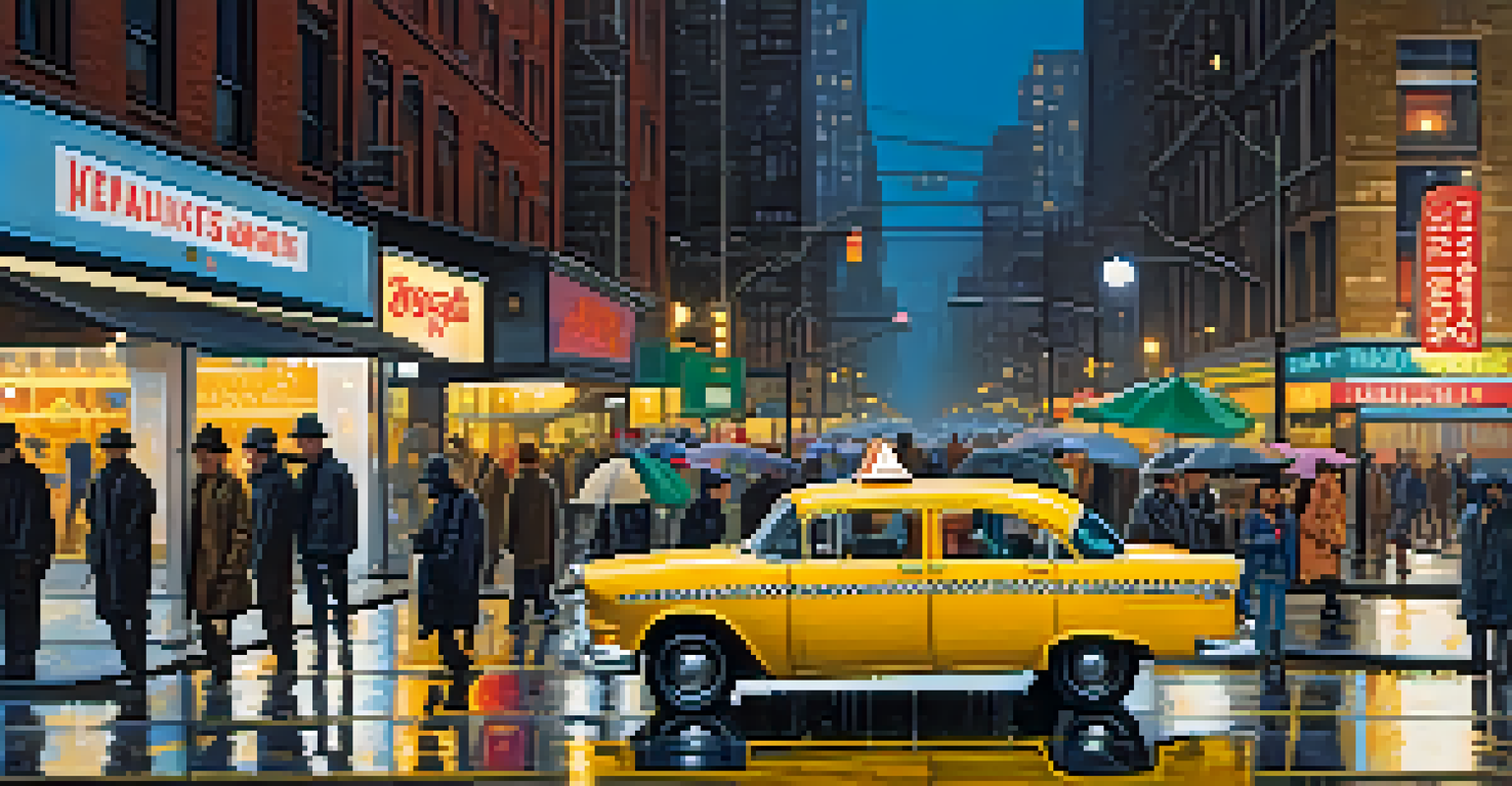Cinematic Tropes: Hollywood's Impact on Global Storytelling

Understanding Cinematic Tropes in Film and Storytelling
Cinematic tropes are storytelling devices that recur across films, helping to shape narratives and audience expectations. Think of them as the building blocks of storytelling—like the classic 'hero's journey' or the 'love triangle.' These familiar elements not only enhance engagement but also create a sense of continuity that audiences can relate to. By tapping into these established frameworks, filmmakers can convey complex ideas in a way that feels accessible and engaging.
Cinematic storytelling is a reflection of our culture, values, and dreams, interwoven with familiar tropes that resonate with audiences around the world.
For example, the 'chosen one' trope, where an ordinary character is thrust into extraordinary circumstances, resonates with viewers because it embodies hope and resilience. This trope appears in various forms, from 'Star Wars' to 'Harry Potter,' showcasing its universal appeal. As audiences recognize these patterns, they become more invested in the story, eagerly anticipating how the character will fulfill their destiny.
However, while tropes can streamline storytelling, it's essential for creators to innovate. Over-reliance on familiar tropes can lead to predictability, potentially alienating audiences. Striking the right balance between using established tropes and introducing fresh narratives is key to maintaining viewer interest.
Hollywood's Dominance in Shaping Global Film Tropes
Hollywood has long been a powerful influence in the film industry, often dictating the trends and tropes that permeate global cinema. With its extensive reach and marketing prowess, Hollywood films are seen and emulated worldwide, making its storytelling conventions ubiquitous. This dominance can be likened to a popular recipe that chefs around the world adapt to their local flavors, ensuring a mix of familiarity and innovation.

For instance, Bollywood often incorporates musical numbers into its narratives, which is a direct adaptation of the vibrant storytelling seen in Hollywood musicals. This blending of styles showcases how Hollywood tropes can inspire creativity in different cultural contexts. As filmmakers worldwide draw inspiration from Hollywood, they often infuse their unique cultural elements, resulting in a rich tapestry of global storytelling.
Cinematic Tropes Enhance Engagement
Familiar storytelling devices like the 'hero's journey' help audiences connect with narratives and anticipate character development.
However, this influence raises questions about originality and cultural appropriation. As local filmmakers adopt Hollywood tropes, they must navigate the fine line between homage and imitation, ensuring their stories remain authentic and reflective of their own cultures.
The Role of Genre in Shaping Cinematic Tropes
Genres in film play a crucial role in establishing specific cinematic tropes that audiences come to expect. Whether it’s the suspenseful twists in thrillers or the heartwarming moments in romantic comedies, each genre has its signature elements that define storytelling. These genre-specific tropes help audiences quickly identify the type of experience they can expect, making it easier for filmmakers to connect with their viewers.
Tropes are the language of storytelling; they are the bridges that connect creators and audiences across different cultures and experiences.
For example, in horror films, the 'final girl' trope—where a lone female character survives—has become a staple. This trope not only heightens tension but also offers a commentary on societal norms and expectations. As genres evolve, they can subvert these tropes, leading to innovative storytelling that challenges audience assumptions.
Moreover, understanding genre-specific tropes allows filmmakers to play with audience expectations, creating a more engaging narrative. By either adhering to or cleverly twisting these conventions, creators can evoke a deeper emotional response, making the story memorable and impactful.
The Influence of Cultural Context on Cinematic Tropes
Cinematic tropes do not exist in a vacuum; they are deeply influenced by cultural context and societal norms. What resonates in one culture may not hold the same meaning in another, leading to significant variations in storytelling. This cultural lens shapes how tropes are portrayed and interpreted, allowing filmmakers to address local issues through familiar narratives.
For example, the portrayal of family dynamics in films can differ significantly between cultures. In Western cinema, themes of individualism often take center stage, while many Asian films may emphasize collective family honor and loyalty. These cultural variations not only enrich storytelling but also foster greater understanding among global audiences.
Hollywood Shapes Global Tropes
Hollywood's influence on global cinema leads to a blending of local storytelling styles with established tropes.
As filmmakers navigate these cultural nuances, they can create stories that resonate on multiple levels, bridging gaps between different societies. This approach not only honors the roots of cinematic tropes but also encourages a more inclusive storytelling landscape.
How Modern Technology is Reshaping Cinematic Tropes
In recent years, advancements in technology have significantly influenced the way cinematic tropes are crafted and perceived. From CGI to streaming platforms, the tools available to filmmakers have expanded the possibilities for storytelling. This shift has led to the emergence of new tropes, such as the 'multiverse' concept, which allows for complex narratives that intertwine multiple worlds and characters.
Moreover, technology has democratized filmmaking, enabling diverse voices to share their stories. Independent filmmakers can now reach global audiences through platforms like Netflix and YouTube, paving the way for a broader range of tropes that reflect varied experiences and perspectives. This influx of new ideas challenges the traditional Hollywood narrative, fostering a more vibrant and diverse storytelling landscape.
As technology continues to evolve, it will be fascinating to see how filmmakers adapt existing tropes and create innovative ones. This ongoing transformation not only enriches the cinematic experience but also keeps audiences engaged and eager for what comes next.
The Role of Audience in Shaping Cinematic Tropes
Audiences play a pivotal role in the evolution of cinematic tropes, as their preferences and reactions help shape the narratives that filmmakers create. Viewer feedback can influence which tropes are embraced, altered, or discarded, reflecting the ever-changing landscape of storytelling. This dynamic relationship between filmmakers and audiences is akin to a dance, where both parties contribute to the rhythm of cinematic evolution.
For instance, the rise of social media has provided a platform for audience engagement, allowing viewers to voice their opinions and preferences more than ever before. This feedback loop often prompts filmmakers to adapt their work, leading to the emergence of new tropes that resonate with contemporary audiences. As a result, filmmakers are increasingly attuned to their audience's desires, aiming to create stories that reflect their experiences.
Technology Redefines Storytelling
Advancements in technology are creating new cinematic tropes and democratizing the filmmaking process, allowing diverse voices to emerge.
Ultimately, this collaborative process enriches the cinematic landscape, fostering innovation and diversity in storytelling. As audience tastes evolve, so too will the tropes that define our films, ensuring that cinema remains a vibrant and reflective medium.
Future Trends: Evolving Cinematic Tropes in Global Storytelling
As we look to the future, it's clear that cinematic tropes will continue to evolve, shaped by cultural shifts and technological advancements. Emerging trends, such as the rise of virtual reality and interactive storytelling, are already pushing the boundaries of traditional narrative structures. This evolution invites filmmakers to explore new ways of engaging audiences while remaining rooted in familiar tropes.
Moreover, as global storytelling continues to flourish, we can expect to see a blending of tropes from different cultures, resulting in rich, multifaceted narratives. This cross-cultural exchange not only enhances storytelling but also fosters greater empathy and understanding among diverse audiences. By embracing this diversity, filmmakers can create stories that resonate on a universal level while honoring their cultural origins.

In conclusion, the landscape of cinematic tropes is ever-changing, influenced by a myriad of factors from technology to audience preferences. As filmmakers navigate this dynamic terrain, they have the opportunity to redefine storytelling, ensuring that cinema remains a vital and relevant form of expression for generations to come.